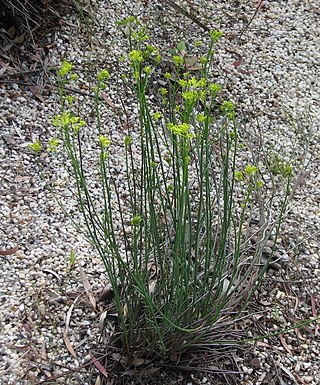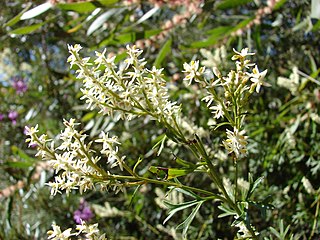
Alectryon is a genus of about 30 species of trees and shrubs from the family Sapindaceae. They grow naturally across Australasia, Papuasia, Melanesia, western Polynesia, east Malesia and Southeast Asia, including across mainland Australia, especially diverse in eastern Queensland and New South Wales, the Torres Strait Islands, New Guinea, the Solomon Islands, New Caledonia, New Zealand, Vanuatu, Fiji, Samoa, Hawaii, Indonesia and the Philippines. They grow in a wide variety of natural habitats, from rainforests, gallery forests and coastal forests to arid savannas and heaths.

Cupaniopsis is a genus of about 67 species of trees and shrubs of the soapberry family, Sapindaceae. They grow naturally in New Guinea, New Caledonia, Australia, Torres Strait Islands, Fiji, Samoa, Sulawesi, Micronesia. Many species have been threatened with extinction globally or nationally, with official recognition by the International Union for Conservation of Nature (IUCN) and several national and state governments.

Austromyrtus is a genus of shrubs in the myrtle family Myrtaceae. Three species are found along the east coast of Australia in Queensland and in New South Wales, and A. lotoides is endemic to New Caledonia. The fruits of A. dulcis have a hint of cinnamon flavouring. The species under this generic name in New Caledonia are being taxonomically revised and will be transferred to another genus.
Pilidiostigma is a genus of shrubs and small trees in the myrtle family Myrtaceae. All species occur in Australia and one, P. papuanum, also occurs in Papua New Guinea. They are not generally known to horticulture. The species P. sessile is rare.

Jagera is a genus of 4 species of forest trees known to science, constituting part of the plant family Sapindaceae.

Castanospora is a monotypic genus of trees, constituting part of the plant family Sapindaceae. The sole species Castanospora alphandii, commonly known as brown tamarind, grows naturally in the Australian rainforests of north-eastern New South Wales and eastern Queensland as far north as the Wet Tropics rainforests of north-eastern Queensland.

Tasmannia stipitata, commonly known as northern pepperbush is a flowering plant in the family Winteraceae and is endemic to eastern Australia. It has narrowly lance-shaped to narrowly elliptic leaves and male and female flowers on separate plants, the male flowers with 21 to 65 stamens and the female flowers with 2 to 9 carpels. The fruit is bluish-violet and contains 12 to 15 seeds.

Atalaya is a genus of eighteen species of trees and shrubs of the plant family Sapindaceae. As of 2013 fourteen species grow naturally in Australia and in neighbouring New Guinea only one endemic species is known to science. Three species are known growing naturally in southern Africa, including two species endemic to South Africa and one species in South Africa, Eswatini and Mozambique.

Mischocarpus is a genus of about nineteen species of trees known to science, constituting part of the plant family Sapindaceae. They grow naturally from Australia and New Guinea, though Malesia as far north as the Philippines, through SE. Asia, Indo-China and S. China, to India at their farthest west. The eleven Australian species known to science grow naturally in the rainforests of the eastern coastal zone of New South Wales and Queensland, from Newcastle northwards through to north-eastern Queensland and Cape York Peninsula.

Pherosphaera fitzgeraldii, commonly known as the Blue Mountains pine or dwarf mountain pine is a species of conifer in the family Podocarpaceae. It is found only in New South Wales, Australia. The entire natural habitat is in the Blue Mountains, from Katoomba to Wentworth Falls, growing almost exclusively in the splash zones of waterfalls, and on the southern aspect of sandstone nearby.

Glischrocaryon is a genus of flowering plants in the family Haloragaceae, endemic to Australia. Species occur in New South Wales, Victoria, South Australia and Western Australia include:

Symphionema is a genus of two species of small shrubs in the family Proteaceae. Both species are endemic to New South Wales in Australia.

Aphanopetalum is a genus of twining shrubs or vines in the family Aphanopetalaceae which are endemic to Australia.

Gymnostachys is a monotypic genus, of the monocotyledon plant family Araceae.

Malaisia scandens, the burny vine or crow ash, is a species of large woody vines, constituting part of the fig plant family. They grow naturally in rainforests in Australia and Malesia. It is the only species in the genus Malaisia.

Hedraianthera is a genus of a sole recognised species of shrubs or small trees endemic to Australia from the family Celastraceae.

Coronidium scorpioides, commonly known as the button everlasting, is a perennial herbaceous shrub in the family Asteraceae found in Australia. Previously known as Helichrysum scorpioides, it was placed in the newly described genus Coronidium in 2008.

Pachymitus is a monotypic plant genus in the mustard family Brassicaceae. The sole species is Pachymitus cardaminoides, commonly known as sand cress, which is native to Australia. It occurs in the states of New South Wales, Victoria and South Australia.

Ozothamnus cuneifolius, commonly known as wedge-leaf everlasting or wedge everlasting, is a shrub in the family Asteraceae. It is native to forests of the south-east of New South Wales and Gippsland in Victoria in Australia.
Canarium australasicum, commonly named mango bark, brown cudgerie or parsnip wood, is a species of rainforest trees, of the plant family Burseraceae. They are endemic to Australia, in eastern Queensland and far northeastern New South Wales.
















